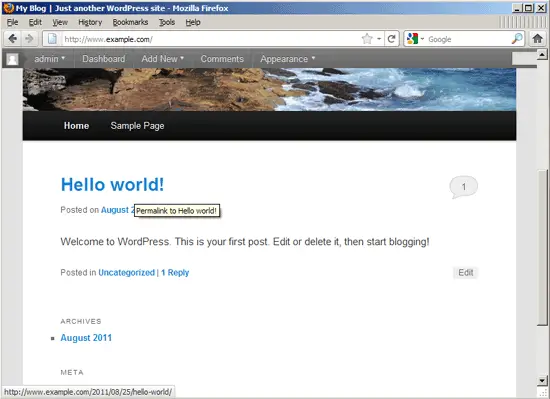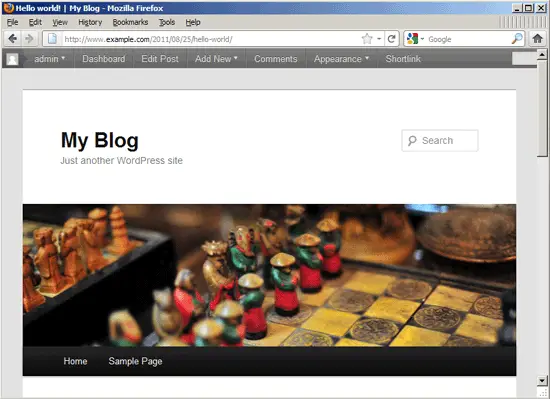Running WordPress On Nginx (LEMP) On Debian Squeeze/Ubuntu 11.04
Version 1.0
Author: Falko Timme
 Follow me on Twitter
Follow me on Twitter
This tutorial shows how you can install and run a WordPress blog on a Debian Squeeze or Ubuntu 11.04 system that has nginx installed instead of Apache (LEMP = Linux + nginx (pronounced "engine x") + MySQL + PHP). In addition to that I will also show you how you can use the WordPress plugins WP Super Cache and W3 Total Cache with nginx. nginx is a HTTP server that uses much less resources than Apache and delivers pages a lot of faster, especially static files.
I do not issue any guarantee that this will work for you!
1 Preliminary Note
I want to install WordPress in a vhost called www.example.com/example.com here with the document root /var/www/www.example.com/web.
You should have a working LEMP installation, as shown in these tutorials:
- Installing Nginx With PHP5 And MySQL Support On Debian Squeeze
- Installing Nginx With PHP5 (And PHP-FPM) And MySQL Support On Ubuntu 11.04
A note for Ubuntu users:
Because we must run all the steps from this tutorial with root privileges, we can either prepend all commands in this tutorial with the string sudo, or we become root right now by typing
sudo su
2 Installing APC
APC is a free and open PHP opcode cacher for caching and optimizing PHP intermediate code. It's similar to other PHP opcode cachers, such as eAccelerator and XCache. It is strongly recommended to have one of these installed to speed up your PHP page.
APC can be installed as follows:
apt-get install php-apc
If you use PHP-FPM as your FastCGI daemon (like in Installing Nginx With PHP5 (And PHP-FPM) And MySQL Support On Ubuntu 11.04), restart it as follows:
/etc/init.d/php5-fpm restart
If you use lighttpd's spawn-fcgi program as your FastCGI daemon (like in Installing Nginx With PHP5 And MySQL Support On Debian Squeeze), we must kill the current spawn-fcgi process (running on port 9000) and create a new one. Run
netstat -tap
to find out the PID of the current spawn-fcgi process:
root@server1:~# netstat -tap
Active Internet connections (servers and established)
Proto Recv-Q Send-Q Local Address Foreign Address State PID/Program name
tcp 0 0 *:sunrpc *:* LISTEN 734/portmap
tcp 0 0 *:www *:* LISTEN 2987/nginx
tcp 0 0 *:ssh *:* LISTEN 1531/sshd
tcp 0 0 *:57174 *:* LISTEN 748/rpc.statd
tcp 0 0 localhost.localdom:smtp *:* LISTEN 1507/exim4
tcp 0 0 localhost.localdom:9000 *:* LISTEN 1542/php5-cgi
tcp 0 0 localhost.localdo:mysql *:* LISTEN 1168/mysqld
tcp 0 52 server1.example.com:ssh 192.168.0.198:2462 ESTABLISHED 1557/0
tcp6 0 0 [::]:www [::]:* LISTEN 2987/nginx
tcp6 0 0 [::]:ssh [::]:* LISTEN 1531/sshd
tcp6 0 0 ip6-localhost:smtp [::]:* LISTEN 1507/exim4
root@server1:~#
In the above output, the PID is 1542, so we can kill the current process as follows:
kill -9 1542
Afterwards we create a new spawn-fcgi process:
/usr/bin/spawn-fcgi -a 127.0.0.1 -p 9000 -u www-data -g www-data -f /usr/bin/php5-cgi -P /var/run/fastcgi-php.pid
3 Installing WordPress
The document root of my www.example.com web site is /var/www/www.example.com/web - if it doesn't exist, create it as follows:
mkdir -p /var/www/www.example.com/web
Next we download Wordpress from http://wordpress.org/latest.tar.gz and place it in our document root:
cd /tmp
wget http://wordpress.org/latest.tar.gz
tar xvfz latest.tar.gz
cd wordpress/
mv * /var/www/www.example.com/web/
It is recommended to make the document root and the WordPress files in it writable by the nginx daemon (otherwise WordPress and its plugins cannot write configuration files) which is running as user www-data and group www-data:
chown -R www-data:www-data /var/www/www.example.com/web
We must rename the wp-config-sample.php file to wp-config.php:
mv /var/www/www.example.com/web/wp-config-sample.php /var/www/www.example.com/web/wp-config.php
If you haven't already created a MySQL database for WordPress (including a MySQL WordPress user), you can do that as follows (I name the database wordpress in this example, and the user is called wp_admin, and his password is wp_admin_password):
mysqladmin -u root -p create wordpress
mysql -u root -p
GRANT ALL PRIVILEGES ON wordpress.* TO 'wp_admin'@'localhost' IDENTIFIED BY 'wp_admin_password';
GRANT ALL PRIVILEGES ON wordpress.* TO 'wp_admin'@'localhost.localdomain' IDENTIFIED BY 'wp_admin_password';
FLUSH PRIVILEGES;
quit;
Open wp-config.php and fill in the correct database details:
vi /var/www/www.example.com/web/wp-config.php
[...]
// ** MySQL settings - You can get this info from your web host ** //
/** The name of the database for WordPress */
define('DB_NAME', 'wordpress');
/** MySQL database username */
define('DB_USER', 'wp_admin');
/** MySQL database password */
define('DB_PASSWORD', 'wp_admin_password');
/** MySQL hostname */
define('DB_HOST', 'localhost');
[...]
|
Next we create an nginx vhost configuration for our www.example.com vhost in the /etc/nginx/sites-available/ directory as follows:
vi /etc/nginx/sites-available/www.example.com.vhost
server {
listen 80;
server_name www.example.com example.com;
root /var/www/www.example.com/web;
if ($http_host != "www.example.com") {
rewrite ^ http://www.example.com$request_uri permanent;
}
index index.php index.html;
location = /favicon.ico {
log_not_found off;
access_log off;
}
location = /robots.txt {
allow all;
log_not_found off;
access_log off;
}
# Deny all attempts to access hidden files such as .htaccess, .htpasswd, .DS_Store (Mac).
location ~ /\. {
deny all;
access_log off;
log_not_found off;
}
location / {
try_files $uri $uri/ /index.php?$args;
}
# Add trailing slash to */wp-admin requests.
rewrite /wp-admin$ $scheme://$host$uri/ permanent;
location ~* \.(jpg|jpeg|png|gif|css|js|ico)$ {
expires max;
log_not_found off;
}
location ~ \.php$ {
try_files $uri =404;
include /etc/nginx/fastcgi_params;
fastcgi_pass 127.0.0.1:9000;
fastcgi_param SCRIPT_FILENAME $document_root$fastcgi_script_name;
}
}
|
To enable that vhost, we create a symlink to it from the /etc/nginx/sites-enabled/ directory:
cd /etc/nginx/sites-enabled/
ln -s /etc/nginx/sites-available/www.example.com.vhost www.example.com.vhost
Reload nginx for the changes to take effect:
/etc/init.d/nginx reload
Now we can launch the web-based WordPress installer by going to http://www.example.com/wp-admin/install.php - fill in the required details and submit the page:
That's it already:
You can now log in to the WordPress admin interface with the username and password you specified during installation:
The first thing you should change are the Permalink Settings (Settings > Permalinks). I recommend to use a permalink structure where no index.php appears (because otherwise you might get problems with caching plugins such as WP Super Cache or W3 Total Cache - nginx will always bypass the cache because it will pass on the request to the PHP interpreter because of the appearance of index.php in the URL). I have used the following structure in my test:
/%year%/%monthnum%/%day%/%postname%/
Mark Custom Structure and fill in the above string, then save the permalink settings:
(If you don't plan to use any caching plugin, then you can use any of the other options as well, including those that contain index.php.)
You can now browse your blog by going to www.example.com (it already contains some test posts/pages), and you should find that your new permalinks work without the need to specify any rewrite rules in your nginx configuration! That is because of this cool little line in our vhost configuration /etc/nginx/sites-available/www.example.com.vhost:
try_files $uri $uri/ /index.php?$args;
If you don't want to use any caching plugins, you are finished now! The next chapter deals with the WordPress cache plugins WP Super Cache and W3 Total Cache.







